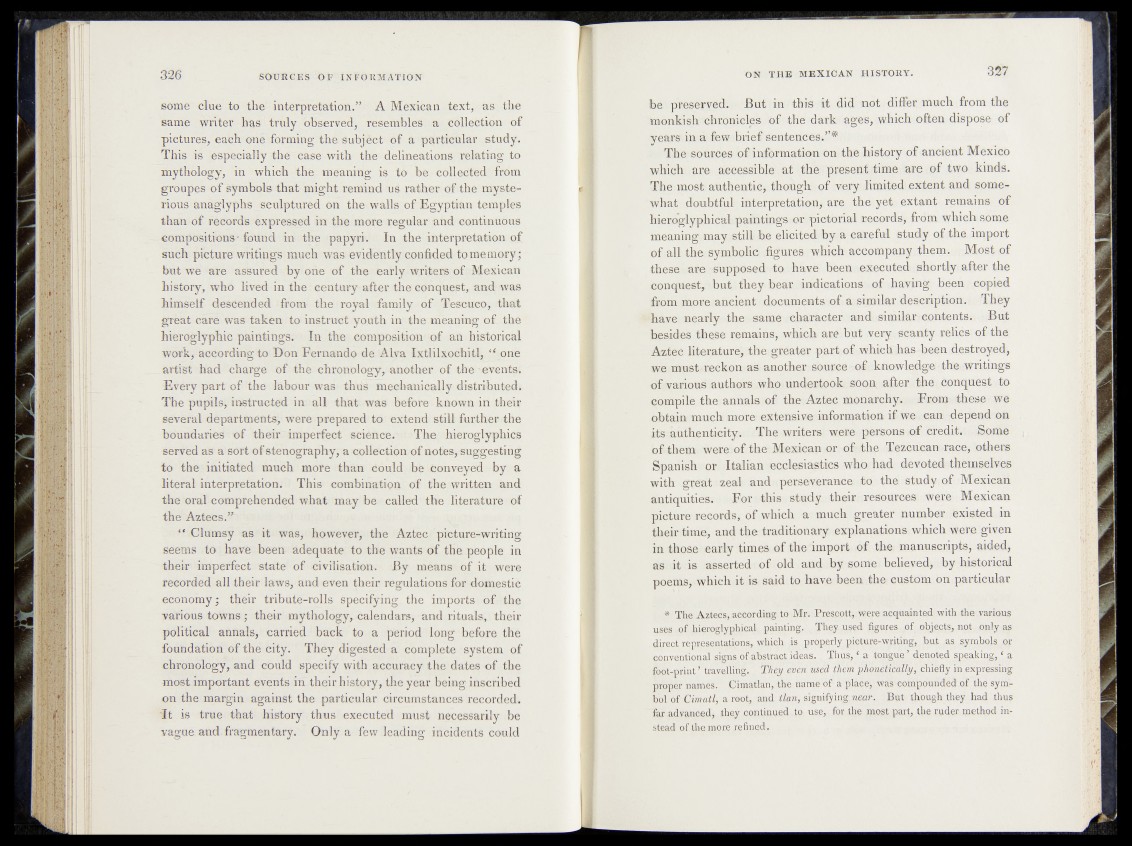
some clue to the interpretation.” A Mexican text, as the
same writer has truly observed, resembles a collection of
pictures, each one forming the Subjèct of a particular study.
This is especially the case with the delineations relating to
mythology, in which the meaning is to he collected from
groupes of symbols that might remind us rather of the mysterious
anaglyphs sculptured on the walls of Egyptian temples
than of records expressed in the more regular and continuous
compositions^' found in the papyri. In the interpretation of
such picture-writings much was evidently confided to memory;
but we are assured by one of the early writers of Mexican
history, who lived in th e: century-after the conquest, and was
himself descended from the royal family of Tcscuco, that
great care was taken to instruct youth in the meaning of the
hieroglyphic paintings. In the composition of an historical
work, according to Don Fernando dé Alva Ixtlilxochitl, “jon®
artist had charge of the chronology, another of the -events.
Every part of the labour was thus mechanically distributedi
The pupils, instructed in all that was before known in their
several departments, were prepared to extend still further the
boundaries x>f their imperfect scierieer The hieroglyphics
served as a sort of stenography, a collection of notes, suggesting
to the initiated much more than could be conveyed by a
literal interpretation. This combination of the written and
the oral comprehended what may be called the literature of
the Aztecs/*
“ Clumsy as it was, however, the Aztec picture-writing
seems to have been adequate to the wants of the people in
their imperfect state of civilisation. By means of it were
recorded all their laws, and even their regulations for domestic
economy; their tribute-rolls specifying., the imports of- the
various towns; their mythology, calendars, and rituals, their
political annals, carried back to a period long before the
foundation of the city. They digested a complete system of
chronology, and could specify with accuracy the dates of the
most important events in their history, the year being inscribed
on the margin against the particular circumstances recorded,
f t is true that history thus executed must necessarily be
vague and. fragmentary. Only a-few leading incidents could
be preserved. But in this it did mot differ much from the
monkish chronicles, of the dark ages, which often dispose of
years in a few brief sentences.”*
The souFces n f information on the history of ancient Mexico
which am accessible at the present time are of two kinds.
The most authentic, though- of very ^limited: extent and somewhat
doubtful interpretation, are the y et» extant remains of
hieroglyphieal paintings or pietbrial records,'from which some
meaning may tstill* h4e elicited by.a Gareful study of^the import
of(aB the. symbolic .»figures whichtatecompany them, Mogl^of
thasi are supposed fo have been^executed,shortly- after the
conquest, - but they bear •indications, )q£ ^having been| copied
from more ancient documeuts ofiassimilar description. They
‘have nearly the same character and^similarjcjobtents. But
besides these tenpins, .which are . but very, scanty relics of the
Aztec literature, thejgreater part o;f whichbas«beent,d#stmycd;,
we must^mckhui as another source - of ; k n<Dwfodg$ sjtlfo-writings
dfiyarious authors who - undertook*:., sooja afiter the, epoquest-do
compile the annals of the Aztec we
obtain much more extertsive information ifweiean depend on
jis.itMheiiliei^i'rv-xThe- writers were personssof credit. Borne
ofithem were.of the Mexican or o fih e . Tezcuqau>race> ^h e rs
Spanish or Italian ecclesiastics who had devotedstheinselves
with great ?iZ€^df and perseverance to the study of Mexusaii
antiquities, For this, study theirfjresouFGest'Were Mexican
picture records, of which a much greater number existed in
their time, and the traditionary explanations which were given
in those early times of the import uèf. the,, manuscripts, aided,
as it is asserted of old and ;by some, believed, ,-by historical
poems,-which it is said to have been thescustom on particular
* The Aztecs, according to Mr. Prescott,-were ncquainted with thetvarion?
uses ,of hi^roglyphicah pairing.
aireot representations) which i§ sgx°p,^ly,
conventional signs of abstra^^a.y/rhus; ‘ a topgu^^Mied ing. ‘ $
foot-print ’ travelling. The^ijenf$sea hiefty iSpxpSlyjg
proper names. Cimatlan, of the symbol
of Cimatl, a root, and ilay,; signify)^ ntar. ,JSgfc tjjpughJthey -had thus
far advanced, .they contjnued^^i^p^fpr^ uw t paat, thftjgder method iii-
stead of the more refined.